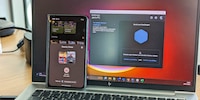
News + Trends
"Nearby Share for Windows" facilitates file sharing between Android and PC
by Jan Johannsen

Google connects Android and Chrome OS with Phone Hub. Although the company manages both sides of the software, it’s less impressive than the competition when it comes to connecting Android and Windows.
I still haven’t found a good connection between an Android smartphone and computer. On closer inspection, Google’s solution with Phone Hub offers even less than the competition. And it doesn’t have as good access to both sides of the software as Google does with Chrome OS and Android.
Phone Hub offers the following functions when you connect your Android smartphone to a Chromebook:
File sharing isn’t integrated into the Phone Hub. It runs via its own service, which Google recently renamed from Nearby Share to Quick Share. It also works between Android devices and integrates Windows computers.
If you activate the notifications in Phone Hub, you’ll see the notifications from your Chromebook in the bottom right-hand corner of Chrome OS. Plus, you’ll see notifications from your smartphone pop up there. This way you know what’s happening on your phone even when you’re on your computer. You can reply to chat messages directly in the notification without opening the app. Very handy indeed!

What’s also good to know is that if you click on a notification, the app opens on the Chromebook. This is helpful if a message is longer than the space for the notification and you want to read it on the Chromebook immediately. Google calls this function app streaming.
What’s less handy is I don’t see all the notifications from my smartphone under Chrome OS. I’d like a menu where you can see which app notifications are visible but I’ve not come across something like this yet.
Being able to access Chrome tabs on your smartphone from your Chromebook sounds practical. However, this isn’t an exclusive function of Phone Hub. At least I don’t see any difference to sharing your browsing history via your Google account, when you sign in to Chrome browsers on different devices.
Phone Hub gives you direct access to the four most recent photos on your smartphone. One click and one of them is downloaded to the Chromebook. It couldn’t be quicker. The only serious disadvantage is that the last four pictures are a pitiful selection.

If you want access to more of your pictures, Phone Hub won’t help you. The only option is to activate synchronisation in the Photos app on the smartphone. You’ll then see the cloud images in the Photos app on the Chromebook too.
With Phone Hub, I can see and operate every app from my smartphone on the Chromebook. However, the transmission isn’t smooth and when I scroll on Instagram, for example, it keeps stopping. It’s not great.

So I ask myself the question, why should I use this beyond the aforementioned clicks on a notification? The apps retain the aspect ratio of the smartphone and are therefore, at best, good for a presentation. If I wanted to work with an Android app, I’d prefer to install it directly from the Play Store on the Chromebook. The advantage? No delays in display and operation. The disadvantage? They take up a bit of the (limited) notebook’s storage space.
However, app streaming is only available for selected devices which must be running at least Android 13:
You can see the battery status of your smartphone via Phone Hub and the connection quality of your mobile network on your Chromebook. But I rarely need that.

The quick commands are more interesting. I use them to activate the hotspot on my smartphone or to mute the phone with a single click. If I’m looking for my phone, I can even make it ring via the Chromebook when it’s muted. I’d be more than happy for Google to expand this area of Phone Hub.
If you want to connect an Android device to a Windows computer, Phone Hub is of no help. I’ve already looked at Phone Link by Microsoft and Ready for by Motorola. I’m not completely convinced by either of them, but they seem to make more sense than the Phone Hub.
With the tools from Microsoft or Motorola, I have access to all the pictures on the smartphone and sometimes even other files. With Phone Link I can control the music playback on my smartphone and make calls via the PC. Ready for lets me use the smartphone as a webcam and has a shared clipboard. So there are plenty of ideas for a wider range of functions in Phone Hub.
Phone Hub is a disappointment. Google is missing out on a hell of a lot of potential for upgrading notebooks with Chrome OS together with Android smartphones.
The notifications are practical because let me take a quick look at the app or reply to messages directly. However, I’m not getting all the notifications from my smartphone. I only have access to the last four photos. The quick commands are helpful, but there aren’t enough of them. App streaming is jerky and makes no sense to me. And I can synchronise the history in Chrome via my Google account and don’t need Phone Hub for that.
Header image: Jan JohannsenAs a primary school pupil, I used to sit in a friend's living room with many of my classmates to play the Super NES. Now I get my hands on the latest technology and test it for you. In recent years at Curved, Computer Bild and Netzwelt, now at Digitec and Galaxus.